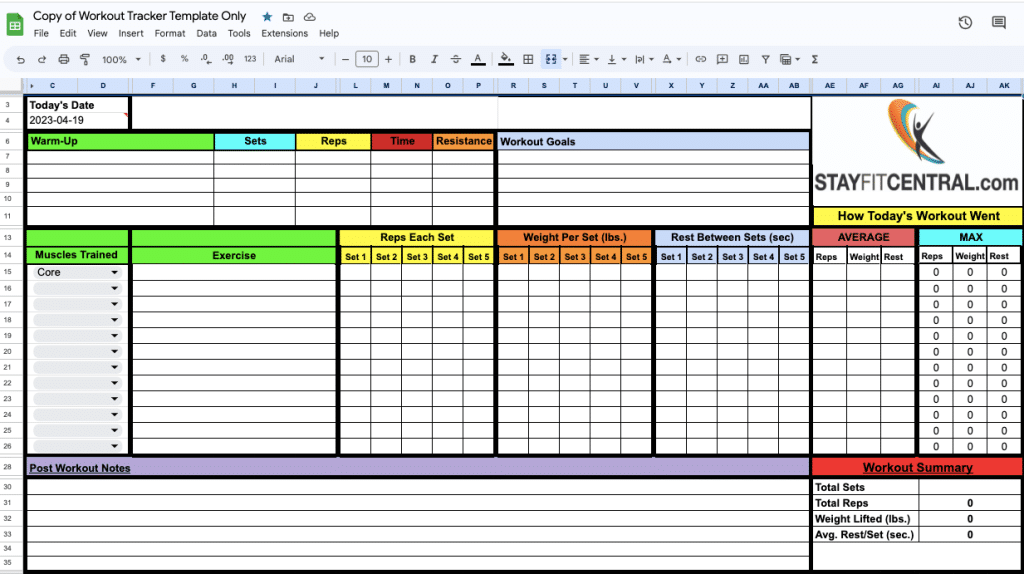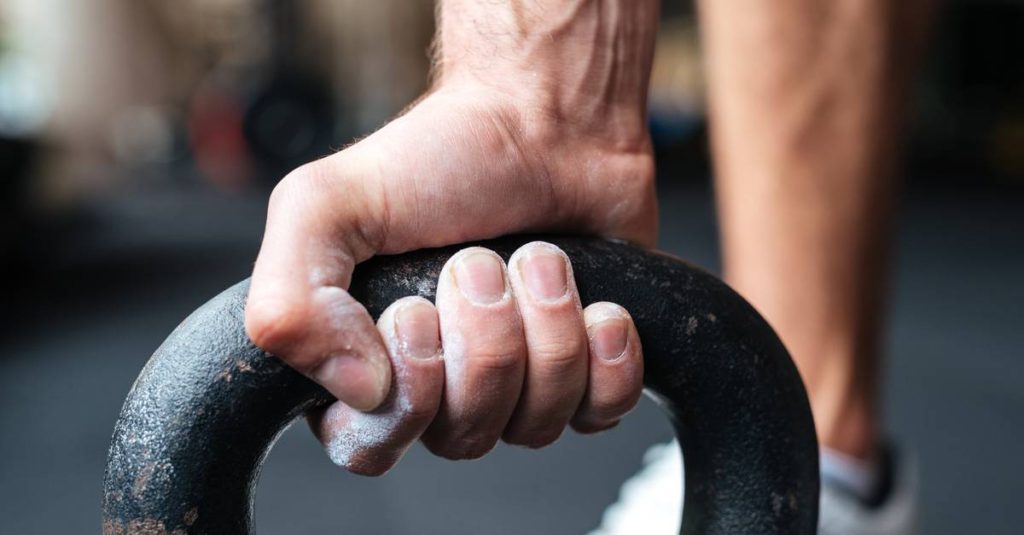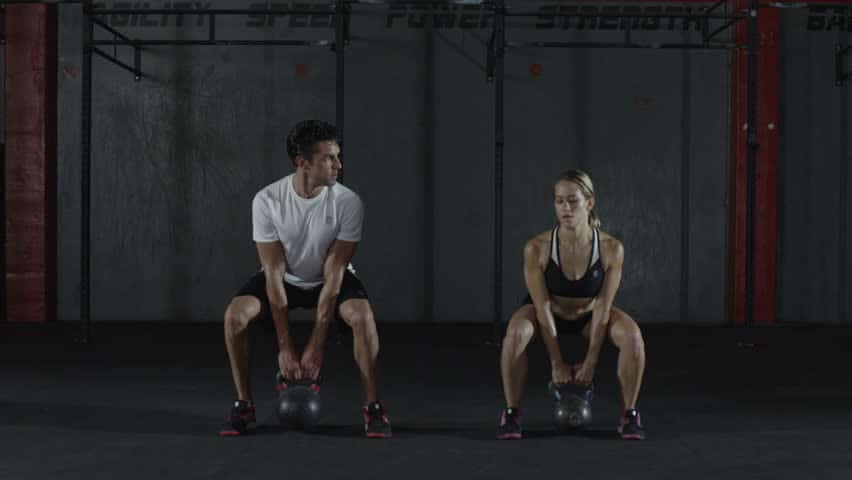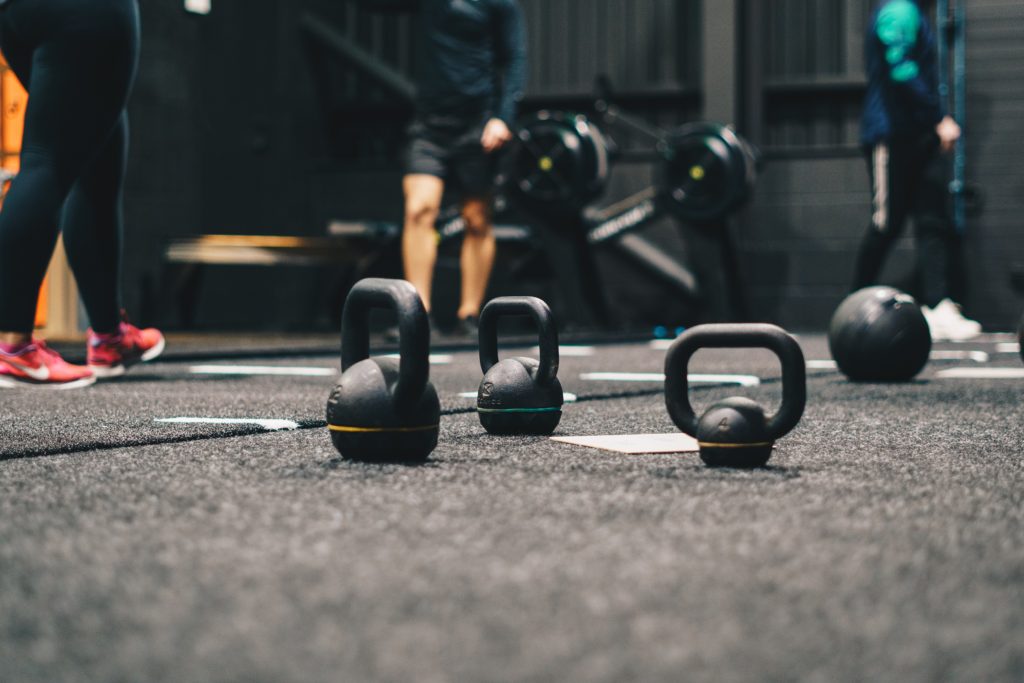Total Body Workouts
The Best Upper/Lower/Full Body Kettlebell Workout
What if I gave you a full body workout that works 10,00% better than the regular style of doing 1 exercise per body part? I bet you’d be stoked and ready to give it a try at your next workout.
Unfortunately I can’t do that. I can only guarantee a 1000% improvement. But I can give you a full body workout that’s really effective and different than the way most are done. This article does that. It’s in the tables below, ready for you to try.
You can refer to it as an upper/lower/full body workout split.
This workout offers a few benefits typical total body workouts don’t. Here are three.
First of all it allows you to do more exercises for each muscle group during the week. This is good for improving any muscles you need to work on, arms or shoulders for example. Having a dedicated day for the upper body means you can do more exercises for these specific muscles.
This workout also eliminates being too fatigued to push yourself at the later stages of your workout. Instead of being too wiped out after doing squats or lunges to put your all into pull ups or presses you’ll be rested and ready to get after it for every exercise.
You’ll also get a little more rest between muscle groups during the week. This is great for your recovery which is when progress is really made.
Ready to see what I’m talking about? Right on. Let’s get started.
What Is An Upper/Lower/Full Body Workout Split?
You’ll train at least 3 days a week. Each workout has its own emphasis. One focuses primarily on upper body exercises. Another lower body movements like squats and lunges. The third workout includes an equal amount of exercises for your upper and lower body.
This workout is great for getting stronger, building muscle, and improving your overall fitness. It also allows you to focus a little bit more on individual muscle groups that could benefit from the extra work.
Let’s get into it so you can give this style of working out a try and let me know how it works for you.

Here’s An Upper/Lower/Total Body Workout For You
What I like most about this workout is that it’s super effective without being complicated.
All you need to do is commit to lifting three non-consecutive days a week. Monday, Wednesday, and Friday for example. You can do cardio, play sports, etc. on Tuesdays and Thursdays. Weekends are for rest or, if you’re recovered from the week and hungry to get after it, other workouts.
Upper/Lower/Total Body Kettlebell Workout Structure
- Workout A (Monday): 4-5 upper and 1-2 lower body exercises
- Workout B (Wednesday): 4-5 lower body and 1-2 upper body exercises
- Workout C (Friday): 2-3 exercises for your upper and lower body
Workouts A and B use straight sets. With straight sets, you’ll rest between each exercise, allowing you to recover adequately. This makes it possible to use heavier weights and do more reps every set.
But what sets Workout C apart is that it’s an AMRAP (As Many Rounds As Possible) workout. This means you’ll be pushing yourself to complete as many rounds of exercises as you can within a set time frame. You do this by doing each exercise in the order given as little rest as possible between them. This will help you build strength, muscle, and improve your cardio.
Start with 10-15 minutes and adjust to meet your needs.
In this next section I give you an 8 week progression plan for the workout and show you how to scale it so it matches your current fitness and experience levels.
The tables below give you the entire training program. Click here to get a free copy of it along with a workout log to track your sets, reps, and weights.
Workout A: Upper Body Emphasis
| Exercise | Sets | Reps | Weight | Rest |
| Turkish Get Ups | 3 | 5 (each side) | Moderate to heavy | 90 seconds |
| Kettlebell Floor Press | 3 | 8 | Moderate to heavy | 90 seconds |
| Kettlebell Bent Over Rows | 3 | 8 | Moderate to heavy | 90 seconds |
| Kettlebell Standing Overhead Press | 3 | 8 | Moderate to heavy | 90 seconds |
| Kettlebell Biceps Curls | 3 | 10 | Moderate to heavy | 60 seconds |
Workout B: Lower Body Emphasis
| Exercise | Sets | Reps | Weight | Rest |
| Kettlebell Windmills | 3 | 6 per side | Moderate to heavy | 60 seconds |
| Goblet Squats | 3 | 8 | Moderate to heavy | 60 seconds |
| Kettlebell Lunges | 3 | 8 per leg | Moderate to heavy | 90 seconds |
| Kettlebell Swings | 2 | 8 | Moderate to heavy | 60 seconds |
| Kettlebell Halos | 3 | 5 each direction | Moderate to heavy | 60 seconds |
Workout C: Equal Upper/Lower Body Emphasis (AMRAP Style)
| Exercise | Sets | Reps | Weight | Rest |
| Kettlebell Front Squats | As many as possible | 8 | Moderate to heavy | 0 |
| Push Ups – Hands On Kettlebells | As many as possible | 8 | Moderate to heavy | 0 |
| 1 Arm Kettlebell Swings | As many as possible | 8 | Moderate to heavy | 0 |
| 1 Arm KB Row | As many as possible | 8 | Moderate to heavy | 0 |
| 1 KB Push Press | As many as possible | 8 | Moderate to heavy | 0 |

Here’s a warm-up and cool down you can do before and after each of these workouts.
Warm Up
| Exercise | Reps | Sets |
| Windmills (no added weight) | 6 per side | 2-3 |
| Bodyweight Split Squats | 8 per leg | 2-3 |
| Arm circles | 10 forward/10 reverse | 2-3 |
Do each movement after the other for the prescribed number of sets. If you want to use some resistance use a light resistance band or a very light weight
Cool-down
| Exercise | Reps | Sets |
| Cat-Cow Stretch | 2 – 60 seconds per rep | 2 |
| Hip Flex Stretch | 2 – 60 seconds per rep | 2 |
8 Week Progression – Upper/Lower/Total Body Kettlebells
Follow these guidelines to make the workout more challenging over time so you get stronger, build muscle, and improve your strength-endurance as much as possible.
Week 1-2: Establishing Form and Technique
- Master proper form and technique for each exercise.
- Start with a weight that allows you to perform every rep with good technique.
- Rest as much as needed between sets.
Week 3-4: Increase The Weights and Intensity
- Increase the weight used or upper (5-10% increase) and lower body exercises (10-15% increase).
- If you don’t have heavier kettlebells you can make the workouts harder during this phase by pausing at the middle of each rep for 5 seconds, lowering the weight slower, or using resistance bands with the kettlebells.
- Maintain the same number of sets and reps as weeks 1-2.
Week 5-6: Adding Sets and Reps
- Add 1-2 sets per exercise.
- Use the same or heavier weights than you used during weeks 3-4.
Week 7-8: Intensifying Supersets and AMRAP
- Use the same – or heavier weights as weeks 5-6 – but rest less between sets.
- Push yourself to complete more rounds within the given time frame.
Remember to listen to your body and adjust the weights and intensity based on your individual capabilities. Always prioritize proper form and technique to minimize the risk of injury.
Scaling This Upper/Lower/Total Body Kettlebell Workout
If You’re A Beginner Or Just Getting Back Into Lifting Weights
- Reduce the number of sets if they make you really tired and sore.
- Take longer rest periods between sets to allow for adequate recovery.
- Push yourself during each set, but always finish with the ability to perform 1-2 more reps to avoid burnout and maintain proper technique.
If You’re Already Pretty Fit And Been Training For More Than 6 Months
- Rest 15-30 seconds less between sets and exercises.
- Add an extra 1-2 sets to each exercise.
- Increase your training frequency to 4, 5, or 6 days a week.
A Final Tip

Remember to listen to your body, adjust weights as needed, and prioritize proper form throughout these advanced modifications. Push your limits, embrace the challenge, and continue to thrive on your fitness journey with this intensified approach!
FAQ: Upper/Lower/Total Body Workout With Kettlebells
What equipment is required?
All that you need are 1-2 kettlebells that are heavy enough for you to do each exercise for the required number of reps and a timer. You can use your watch or timer app on your phone. I use the smartWOD app since it’s designed for this type of workout.
Can I repeat this workout after 8 weeks?
Absolutely! After completing the eight-week cycle of this workout, you can certainly repeat it to continue challenging your body and making progress. You can also try another total body kettlebell workout like this one. However, to ensure continued growth and adaptation, it’s beneficial to introduce some variations and modifications.
Here’s what you can do differently when repeating the workout:
1. Increase Resistance: As you start the new cycle, aim to use slightly heavier weights compared to your previous round. Gradually increase the resistance to maintain the challenge and stimulate further strength and muscle gains.
2. Modify Exercises: Swap out some of the exercises with alternative variations that target the same muscle groups. This helps prevent plateauing and adds variety to your routine, keeping it fresh and engaging.
3. Change Rep Ranges and Sets: Adjust the rep ranges and sets to provide a new stimulus to your muscles. You can incorporate lower rep ranges with heavier weights for strength gains or higher rep ranges for muscular endurance. Similarly, altering the number of sets can add a different training effect.
4. Introduce Advanced Techniques: Explore advanced training techniques like drop sets, supersets, or pyramid sets to challenge your body in new ways. These techniques can enhance intensity, increase metabolic stress, and stimulate muscle growth.
5. Periodize Your Training: Consider incorporating periodization principles, such as varying intensity and volume across different phases, to optimize your progress. This structured approach can help you peak at specific times and prevent overtraining.
6. Give another full body workout a try. We’ve published two that you’ll like. The first is a full body kettlebell workout that is so powerful it only needs 3 exercises. The other is a kettlebell complex that can help you build muscle get stronger and improve your endurance at the same time.
Can I do this workout more than 3 times a week?
If you’re interested in increasing the frequency of the workout to 4, 5, or 6 times a week, it’s important to adjust the training split and exercise selection to allow for adequate recovery and prevent overtraining.
Here’s a breakdown of how you can structure the workouts.
Upper/Lower/Total Body Workout 4 Times a Week
Option 1
- Week 1:
- Workout A
- Workout B
- Workout C
- Workout A
- Week 2:
- Workout B
- Workout C
- Workout A
- Workout B
- Alternate between the order of the workouts each week.
Option 2
- Perform Workouts A, B, C, on 3 non-consecutive days and do an additional workout of your choice where you focus on a specific muscle group or exercises.
Upper/Lower/Total Body Workout Done 5 Times a Week
- Week 1: A, B, C, A, B
- Week 2: C, A, B, C, B
- Week 3 and on: rotate your workouts starting with the one that comes after the last one you did the week before.
- Add in a rest day if needed or take the weekends off for cardio and recovery.
Upper/Lower/Total Body Kettlebell Workout 6 Times a Week
- Week 1: Perform the workouts in this order: A, B, C, A, B, C
- Repeat this cycle every week. Take one day off every week to rest and recover.
Conclusion
The Upper/Lower/Total Body Kettlebell Workout Split makes getting stronger, building muscle, and supercharging your fitness possible. In just 3 workouts a week. If you want to train more often it’s easy to adjust for 4, 5, even 6 weekly workouts.
Tracking your workouts using something like our Google Sheets workout log enables you to monitor performance, set goals, and make informed adjustments. This invaluable tool empowers you to measure your advancement and maintain steady momentum on your fitness journey.
So, take the plunge and embark on this transformative workout style. Embrace the challenge, listen to your body, and keep striving for improvement. With dedication and the support of the workout tracker, you’ll undoubtedly witness the rewarding transformation of your physical prowess. Happy lifting!
- Why You Should Buy An AI Personal Trainer - April 5, 2024
- Before You Buy –Features Personalized AI Workouts Require - March 20, 2024
- AI Workouts Have Come To The Super Bowl - February 7, 2024

